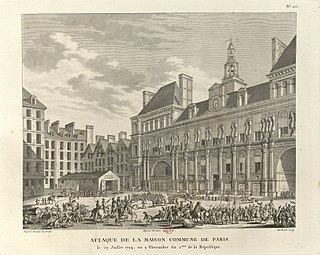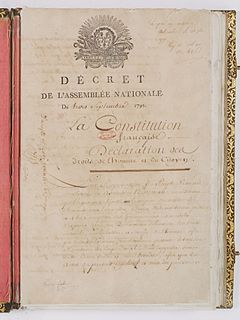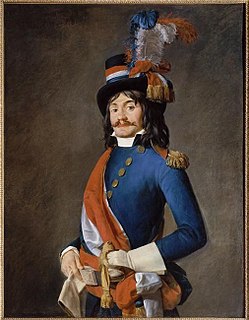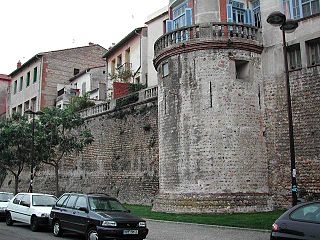In politics, a national assembly is either a unicameral legislature, the lower house of a bicameral legislature, or both houses of a bicameral legislature together. In the English language it generally means "an assembly composed of the representatives of the nation." The population base represented by this name is manifestly the nation as a whole, as opposed to a geographically select population, such as that represented by a provincial assembly. The powers of a National Assembly vary according to the type of government. It may possess all the powers of government, generally governing by committee, or it may function solely within the legislative branch of the government.

The War of the First Coalition was a set of wars that several European powers fought between 1792 and 1797 initially against the constitutional Kingdom of France and then the French Republic that succeeded it. They were only loosely allied and fought without much apparent coordination or agreement; each power had its eye on a different part of France it wanted to appropriate after a French defeat, which never occurred.

The National Convention was a parliament of the French Revolution, following the two-year National Constituent Assembly and the one-year Legislative Assembly. Created after the great insurrection of 10 August 1792, it was the first French government organized as a republic, abandoning the monarchy altogether. The Convention sat as a single-chamber assembly from 20 September 1792 to 26 October 1795.

François-Antoine, Count of the Empire (1756–1826) was a French writer, lawyer and politician during the Revolution and the Empire.

The Paris Commune during the French Revolution was the government of Paris from 1789 until 1795. Established in the Hôtel de Ville just after the storming of the Bastille, it consisted of 144 delegates elected by the 60 divisions of the city. Before its formal establishment, there had been much popular discontent on the streets of Paris over who represented the true Commune, and who had the right to rule the Parisian people. The first mayor was Jean Sylvain Bailly, a relatively moderate Feuillant who supported constitutional monarchy. He was succeeded in November 1791 by Pétion de Villeneuve after Bailly's unpopular use of the National Guard to disperse a riotous assembly in the Champ de Mars.
An intendant was and sometimes still is a usually public official, especially in France, Spain, Portugal, and Latin America. The intendancy system was a centralizing administrative system developed in France. In the War of the Spanish Succession of 1701 to 1714 the French royal House of Bourbon secured its hold on the throne of Spain; it extended a French-style intendancy system to Spain and Portugal - and subsequently worldwide through the Spanish Empire and Portuguese Empire. Regions were divided into districts, each administered by an intendant. The title continues in use in Spain and in parts of Spanish America for particular government officials.

A prefect in France is the state's representative in a department or region. Subprefects are responsible for the subdivisions of departments, arrondissements. The office of a prefect is known as a prefecture and that of a sub-prefect as a subprefecture.

The French Constitution of 1791 was the first written constitution in France, created after the collapse of the absolute monarchy of the Ancien Régime. One of the basic precepts of the French Revolution was adopting constitutionality and establishing popular sovereignty.

The Storming of the Bastille was an event that occurred in Paris, France, on the afternoon of 14 July 1789, when revolutionaries stormed and seized control of the medieval armory, fortress, and political prison known as the Bastille. At the time, the Bastille represented royal authority in the centre of Paris. The prison contained only seven inmates at the time of its storming, but was seen by the revolutionaries as a symbol of the monarchy's abuse of power; its fall was the flashpoint of the French Revolution.

The Ancien Régime, also known as the Old Regime, was the political and social system of the Kingdom of France from the Late Middle Ages until the French Revolution starting in 1789, which abolished the feudal system of the French nobility (1790) and hereditary monarchy (1792). The Valois dynasty ruled during the Ancien Régime up until 1589 and was then replaced by the Bourbon dynasty. The term is occasionally used to refer to the similar feudal systems of the time elsewhere in Europe such as that of Switzerland.

The Army of the Eastern Pyrenees was one of the French Revolutionary armies. It fought against the Kingdom of Spain in Roussillon, the Cerdanya and Catalonia during the War of the Pyrenees. This army and the Army of the Western Pyrenees were formed by splitting the original Army of the Pyrenees at the end of April 1793 soon after the war started. Shortly after the Peace of Basel on 22 July 1795, the fighting ended and the army was dissolved on 12 October that same year. Many of its units and generals were transferred to join the Army of Italy and fought under Napoleon Bonaparte in 1796.

During the French Revolution, a représentant en mission was an extraordinary envoy of the Legislative Assembly (1791–92) and its successor the National Convention (1792–95). The term is most often assigned to deputies designated by the National Convention for maintaining law and order in the départements and armies, as they had powers to oversee conscription into the army, and were used to monitor local military command. At the time France was in crisis; not only was war going badly, as French forces were being pushed out of Belgium, but also there was revolt in the Vendée over conscription into the army and resentment of the Civil Constitution of the Clergy.

Jean Victor Tharreau or Jean Victor Thareau, was a General of Division in the Army of the French Empire.
Antoine René Charles Mathurin, comte de Laforêt was a senior French diplomat. He was Consul General of France to the United States before the French Revolution. During the First French Empire he was Ambassador in Madrid. He was briefly Minister of Foreign Affairs during the transitional government after the fall of Napoleon in 1814, and in 1815, after second abdication of Napoleon, a plenipotentiary to the Seventh Coalition powers.

At the Battle of Peyrestortes in the War of the Pyrenees, soldiers of the First French Republic defeated a Spanish army that had invaded Roussillon and was attempting to capture Perpignan. The Spanish army of Antonio Ricardos had occupied part of Roussillon and made an abortive attempt to seize the fortress of Perpignan in July 1793. At the end of August, the Spanish commander sent two divisions on a sweep around the western side of Perpignan in an attempt to isolate the fortress and choke it off from resupply. After an initial Spanish success, the French army commander Hilarion Paul Puget de Barbantane, lost his nerve and fled from the area.
The revolt of Lyon against the National Convention was a counter-revolutionary movement in the city of Lyon during the time of the French Revolution. It was a revolt of moderates against the more radical National Convention, the third government during the French Revolution. It broke out in June 1793 and was put down in October of the same year, after government forces had besieged the city.

Pierre Magne was a lawyer and French politician. He was a member of parliament from 1843 to 1848, a senator in the Second French Empire, and a representative and then senator in the French Third Republic. He was Minister of Finance several times.

The Battle of Collioure saw troops from Spain attack a French division during the War of the Pyrenees. The Spanish troops led by Gregorio García de la Cuesta were completely successful in ousting the French under Louis Pierre François Delattre from Collioure, Fort Saint-Elme and Port-Vendres. The contending sides were the Spanish Army of Catalonia commanded by Antonio Ricardos and the French Army of the Eastern Pyrenees led by François Amédée Doppet and Eustache Charles d'Aoust. In September 1793, the French successfully defended Perpignan from Spanish attack but December saw a series of French defeats. One of the French representatives on mission, Claude Dominique Côme Fabre was killed during the fighting at Collioure. Aoust and Delattre were arrested, condemned and executed by guillotine for the disaster.

Edme Viala Charon, Baron Charon was a French soldier who rose to the rank of Lieutenant General . He was briefly Governor General of Algeria during the French Second Republic, and was a senator of France for most of the Second French Empire.

Antoine Simon Durrieu was a French General and politician. He was born on 20 July 1775 in Grenade-sur-l'Adour (Landes) and died on 7 April 1862 in Saint-Sever (Landes).






























